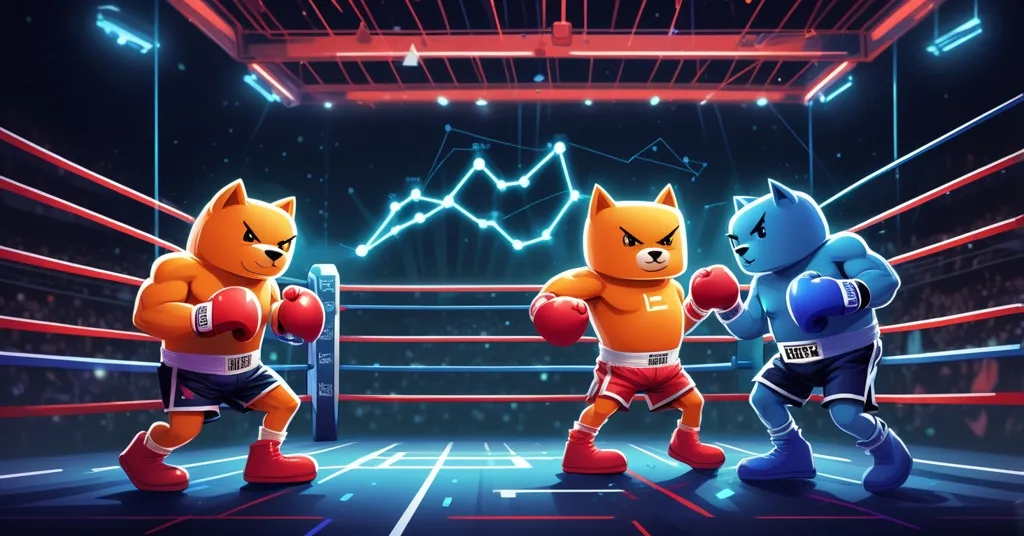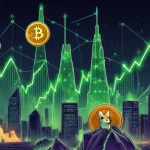Solana’s Vibhu Norby Challenges Ripple to Live Data Duel Over XRP’s Stagnant Metrics

Solana’s Vibhu Norby Throws Down the Gauntlet: Challenges Ripple and XRP Community to a Live Data Showdown
Vibhu Norby, head of Product Marketing at the Solana Foundation, has fired a shot across the bow, challenging Ripple executives and the XRP community to a live, public debate on the X platform, centered squarely on verifiable on-chain data. This isn’t just a petty squabble—it’s a call for accountability in a crypto world too often drowned in hype, and Norby is fed up with what he sees as XRP’s stagnant performance being swept under the rug.
- Debate Dare: Norby demands a facts-only discussion with Ripple and XRP defenders, focusing on hard blockchain metrics.
- Numbers Gap: Solana boasts 2.5M daily active accounts vs. XRP’s 25K, and 100M daily transactions vs. XRP’s 1-1.5M.
- Mixed Fortunes: XRP’s market cap hit $170.3B in Q3, but utility doubts and a recent price drop cast shadows.
The Data Disparity: Solana vs. XRP by the Numbers
Let’s cut to the chase: the numbers tell a brutal story. Norby, an engineer with a nose for truth, has pointed out that the XRP Ledger has been sleepwalking through the last three years with a measly 25,000 daily active accounts. Transaction volumes aren’t much better, limping along at 1 to 1.5 million per day. Meanwhile, Solana is flexing hard with 2.5 million daily active accounts and a mind-blowing 100 million daily transactions. That’s not a gap—it’s a chasm.
For those new to the game, on-chain data is the raw, unfiltered truth of a blockchain’s health, recorded directly on its ledger. Daily active accounts show how many unique users are actually interacting with the network—think of it as a daily headcount of engagement. Transaction volumes, on the other hand, measure the total activity, from simple token transfers to complex interactions with smart contracts, which are automated agreements that execute without middlemen, like a digital vending machine for deals. Solana’s massive stats suggest a buzzing ecosystem, while XRP’s numbers hint at a ghost town.
The disparity doesn’t stop there. When it comes to stablecoin transfer volumes—a key marker of how much real value is moving on a chain—XRP handles $50-60 billion monthly. Decent, until you see Solana’s nearly $2 trillion in October alone. Stablecoins, for the uninitiated, are cryptocurrencies pegged to stable assets like the US dollar, often used for payments or settlements. Their transfer volume is a window into economic activity on a blockchain, and Solana is running a financial freeway while XRP’s stuck in a cul-de-sac.
Solana’s Scalability Swagger: What’s Driving the Frenzy?
Solana’s dominance in raw metrics isn’t random. Its blockchain is built for speed and low costs, making it a darling for developers and users alike. Popular Decentralized Finance (DeFi) platforms—tools for lending, borrowing, or trading without banks—like Raydium, along with bustling NFT marketplaces, drive insane user engagement. Solana’s high throughput allows it to process transactions at a scale that older networks struggle to match, positioning it as a hub for cutting-edge applications.
But let’s not crown Solana the unchallenged king just yet. Its impressive stats come with baggage. The network has faced repeated outages, notably in 2021 and 2022, when it went dark under heavy load. Those hiccups raised eyebrows about reliability—something XRP Ledger, to its credit, rarely struggles with. So while Solana’s numbers scream success, there’s a whisper of vulnerability that Norby might not highlight in his data duel.
XRP’s Market Mirage: Hype vs. Hard Reality
XRP isn’t without its victories, though. In Q3, it soared to an all-time high price of $2.85, a 27.2% jump, and its circulating market cap swelled to $170.3 billion—a 29% increase that outpaced the combined market cap growth of Bitcoin, Ethereum, and Solana at 13.3%. That’s a serious flex, and the XRP community has been reveling in the glow. Add to that the recent Nasdaq listing of Evernorth, a Ripple-backed crypto venture, and there’s a whiff of institutional momentum that could hint at bigger adoption in traditional finance.
But hold the confetti. October delivered a cold shower with a 12% price drop to around $2.50, driven by bearish market vibes after the US Federal Reserve flashed hawkish signals—basically, hints they might hike interest rates to slow the economy, which spooks crypto investors as money tightens up. Market cap aside, the real sting comes from lingering doubts about XRP’s utility. Designed as a neutral bridge for fast, cheap cross-border payments, it’s supposed to be the darling of financial systems. Yet, as analyst Scott Melker, aka “The Wolf of All Streets,” bluntly puts it, giants like SWIFT and Western Union aren’t touching it. If the big players aren’t on board, who’s actually using XRP beyond speculative trading?
Ripple’s Side of the Story: Why the Stagnation?
Before we pile on XRP, let’s consider Ripple’s potential defense. One elephant in the room is the ongoing legal battle with the SEC, which kicked off in 2020 over whether XRP is an unregistered security. This regulatory cloud has likely scared off institutional partners and stunted network growth. Why commit to a blockchain mired in legal uncertainty when safer bets exist? Ripple’s focus might also be narrower—targeting specific partnerships over raw transaction volume. Their vision isn’t about dApps or NFT hype; it’s about rewiring global payments, even if progress is glacial.
Still, excuses only go so far. Three years of flat metrics isn’t just a hiccup—it’s a red flag. XRP defenders might argue it’s a marathon, not a sprint, and that institutional adoption takes time. Fair enough, but in a space moving at warp speed, patience isn’t always a virtue. If Ripple execs step up to Norby’s challenge, as detailed in this public call for a live debate, they’d better bring more than platitudes to the table.
A Brief History of Solana vs. XRP Rivalries
This isn’t the first time Solana and XRP have been pitted against each other. Since Solana’s rise around 2020, fueled by its promise of scalability, it’s often been compared to older networks like XRP Ledger, which launched in 2012 with a focus on cross-border transfers. Solana’s developer-friendly ecosystem has drawn contrasts with XRP’s more singular mission, sparking debates over what defines a blockchain’s success—raw activity or niche utility. Past spats on social platforms have seen Solana advocates touting throughput while XRP loyalists emphasize Ripple’s ties to traditional finance. Norby’s challenge is just the latest chapter in a long-running saga of competing visions.
What’s at Stake in This Data Duel?
Norby’s call-out isn’t just about dunking on XRP for clout. It’s a high-stakes moment that could sway investor sentiment and developer focus. If Ripple and the XRP community dodge this debate, the silence could scream louder than any rebuttal, reinforcing perceptions of weakness. If they engage and flounder on data, it might dent XRP’s credibility further. But if they muster a solid defense—say, proof of under-the-radar adoption or a roadmap to growth—they could flip the narrative.
For Solana, the risk is overconfidence. Painting XRP as a has-been ignores Solana’s own flaws, and any misstep in the debate could backfire. Beyond the two players, this showdown matters to the broader crypto crowd. It’s a test of whether substance can outshine spin, and whether communities are ready to face uncomfortable truths. For newcomers, it’s a crash course in why metrics matter; for OGs, it’s a reminder that no project is untouchable.
Why This Matters to the Crypto Revolution
As a Bitcoin maximalist, I’ll always argue that BTC is the gold standard of decentralized money—a store of value and a middle finger to centralized control that no altcoin can fully replicate. But I’m not blind to the roles others play. Solana’s dApp dominance and Ethereum’s smart contract empire fill gaps Bitcoin shouldn’t touch. XRP’s dream of revolutionizing payments could still fit into this puzzle—if it delivers. Norby’s push for a data-driven reckoning aligns with the ethos of decentralization and transparency we champion. In a space littered with scams and moonboy nonsense, demanding hard facts is a step toward the freedom and disruption we’re fighting for.
This debate, if it happens, is more than a sidebar. It’s a wake-up call for every blockchain project: the numbers don’t lie, and the community is hungry for substance over swagger. Whether Ripple steps into the ring or not, the blockchain world is watching. Let’s hope the conversation does justice to the tech we believe can reshape finance, privacy, and power itself.
Key Takeaways and Questions to Ponder
- What’s driving Vibhu Norby’s challenge to Ripple and the XRP community?
Norby is frustrated by XRP’s stagnant on-chain metrics compared to its hype, pushing for a public, facts-first discussion to expose the disconnect. - How do Solana and XRP Ledger compare in network activity?
Solana obliterates XRP with 2.5 million daily active accounts to XRP’s 25,000 and 100 million daily transactions to XRP’s 1-1.5 million—a stark usage gap. - Does XRP’s market performance validate its potential?
A $170.3 billion market cap and Q3 peak of $2.85 look impressive, but a 12% October drop and utility doubts cloud the picture. - Why is XRP’s real-world utility under scrutiny?
Analysts like Scott Melker highlight that major financial players like SWIFT and Western Union aren’t using XRP, questioning its role as a payment bridge. - What challenges does Solana face despite its dominance?
Solana’s past network outages in 2021 and 2022 raise reliability concerns, a weak spot that contrasts with XRP’s stability. - Could regulatory issues explain XRP’s stagnation?
Ripple’s SEC lawsuit since 2020 likely deters institutional adoption, potentially stunting network growth despite its payment-focused vision. - How might this debate impact the crypto space?
A live discussion could reshape perceptions of XRP and Solana, influencing investor trust and developer focus while pushing for transparency across projects.



